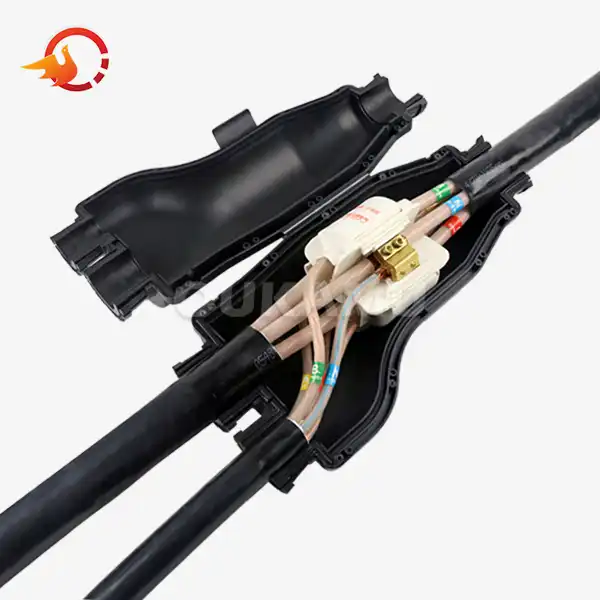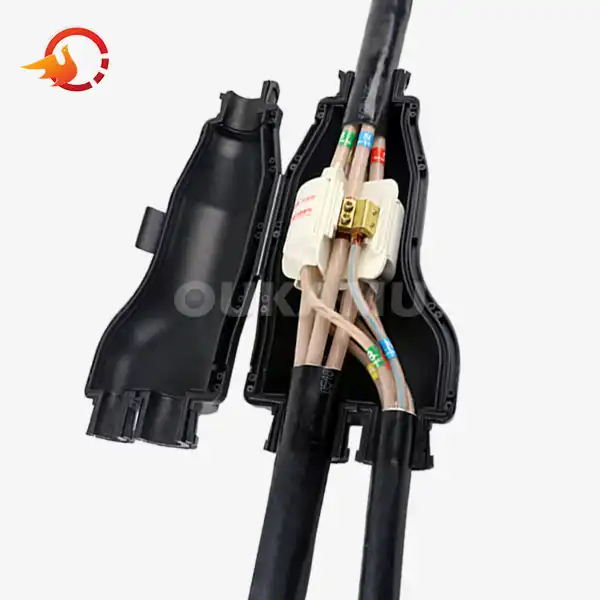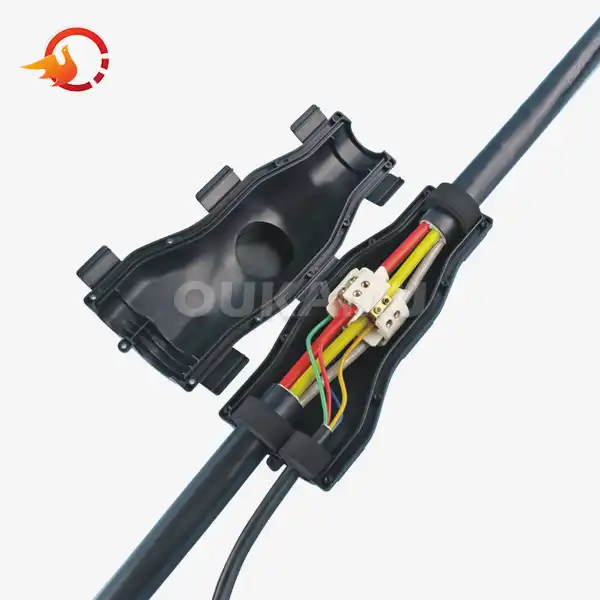Are High Voltage Armoured Cable Branch Joints Different?
 2025-08-15 08:22:21
View:389
2025-08-15 08:22:21
View:389In the world of electrical engineering, armoured cable branch joints play a crucial role in ensuring safe and efficient power distribution. While many are familiar with low voltage applications, high voltage systems present unique challenges and requirements. This article explores the key differences between high and low voltage armoured cable branch joints, their applications in high voltage systems, and the essential features that make high voltage joints stand out.
Differences Between High and Low Voltage Armoured Joints
High voltage armoured cable branch joints differ significantly from their low voltage counterparts in several aspects:
Insulation Requirements
High voltage joints require superior insulation to withstand the immense electrical stress. While low voltage joints may use simple rubber or plastic insulation, high voltage joints often incorporate advanced materials like ethylene propylene rubber (EPR) or cross-linked polyethylene (XLPE). These materials provide excellent dielectric strength and thermal stability, crucial for maintaining insulation integrity under high electrical stress.
Stress Control
In high voltage applications, electrical stress management is paramount. High voltage armoured cable branch joints incorporate sophisticated stress control systems, such as stress cones or field grading materials. These components help distribute electrical stress evenly across the joint, preventing localized stress concentrations that could lead to insulation breakdown.
Size and Complexity
High voltage armoured cable branch joints are generally larger and more complex than low voltage joints. This increased size accommodates the additional insulation, stress control components, and protective layers required to handle high voltage applications. The complexity also extends to the installation process, which often requires specialized tools and expertise.
Environmental Protection
While both high and low voltage joints need environmental protection, high voltage joints demand superior sealing and moisture resistance. They often incorporate multiple layers of protective materials, including heat-shrink tubes, mastics, and semi-conductive layers, to ensure long-term reliability in challenging environments.
Testing and Quality Control
High voltage armoured cable branch joints undergo more rigorous testing procedures compared to low voltage joints. These tests include partial discharge measurements, AC voltage withstand tests, and impulse voltage tests, ensuring the joint can withstand extreme electrical conditions without failure.
Applications of Armoured Cable Branch Joints in HV Systems
High voltage armoured cable branch joints find applications in various sectors where reliable power distribution is critical:
Power Transmission Networks
In national and regional power grids, high voltage armoured cable branch joints are essential for connecting main transmission lines to substations or for creating network redundancies. These joints must withstand extreme voltages, often exceeding 100kV, while ensuring minimal power losses.
Renewable Energy Integration
As renewable energy sources like offshore wind farms and large-scale solar installations become more prevalent, high voltage armoured cable branch joints play a crucial role in connecting these power sources to the grid. They must withstand harsh environmental conditions while maintaining optimal performance.
Industrial Complexes
Large industrial facilities, such as steel mills or chemical plants, often require high voltage power distribution systems. Armoured cable branch joints in these settings must withstand not only high voltages but also potentially corrosive or hazardous environments.
Urban Infrastructure
In densely populated urban areas, underground high voltage distribution networks rely on armoured cable branch joints to provide reliable power to various sectors. These joints must be compact yet robust, capable of withstanding thermal cycling and potential water ingress.
Transportation Systems
High-speed rail networks and electric vehicle charging infrastructure often utilize high voltage power systems. Armoured cable branch joints in these applications must withstand mechanical stress from vibrations while maintaining electrical integrity.
Key Features of High Voltage Armoured Cable Branch Joints
To meet the demanding requirements of high voltage applications, armoured cable branch joints incorporate several key features:
Advanced Insulation Systems
High voltage joints utilize state-of-the-art insulation materials that offer superior dielectric strength and long-term stability. These may include specially formulated silicone rubbers or hybrid insulation systems that combine multiple materials for optimal performance.
Integrated Stress Control
Modern high voltage armoured cable branch joints feature integrated stress control systems. These may include geometric stress control cones, field grading materials, or a combination of both. The stress control system ensures a uniform electric field distribution, preventing hotspots that could lead to premature failure.
Robust Mechanical Design
High voltage joints must withstand not only electrical stress but also mechanical forces. The design often incorporates reinforced outer layers, sometimes including metallic shielding, to protect against impact, compression, and bending stresses.
Enhanced Sealing Technology
To prevent moisture ingress and ensure long-term reliability, high voltage armoured cable branch joints employ advanced sealing technologies. These may include multi-layer heat-shrink systems, cold-shrink technology, or resin-based sealing methods, depending on the specific application requirements.
Partial Discharge Suppression
Partial discharges can significantly degrade insulation over time. High voltage joints incorporate features to suppress partial discharges, such as specially designed semiconductive layers or void-filling compounds that eliminate air pockets within the joint.
Modular Design
Many modern high voltage armoured cable branch joints feature modular designs. This approach allows for easier installation and cable maintenance, reducing downtime and improving overall system reliability. Modular designs also facilitate customization for specific voltage levels or environmental conditions.
Fire-Resistant Properties
In critical installations, high voltage armoured cable branch joints may require fire-resistant properties. Advanced formulations of insulating and jacketing materials provide enhanced fire resistance, ensuring system integrity even under extreme conditions.
Customizable Configurations
High voltage armoured cable branch joints often need to accommodate various cable types and sizes. Leading manufacturers offer customizable configurations that can adapt to different conductor materials, cross-sections, and shielding arrangements while maintaining optimal electrical performance.
Environmental Sustainability
With growing emphasis on environmental concerns, modern high voltage armoured cable branch joints are designed with sustainability in mind. This includes the use of halogen-free materials, recyclable components, and manufacturing processes that minimize environmental impact.
Conclusion
High voltage armoured cable branch joints represent a critical component in modern power distribution systems. Their unique design features, advanced materials, and sophisticated engineering make them distinctly different from low voltage joints. As power grids continue to evolve, incorporating more renewable sources and smart technologies, the role of high voltage armoured cable branch joints will only grow in importance.
Understanding these differences is crucial for engineers, contractors, and facility managers involved in high voltage power distribution projects. By selecting the appropriate joint technology and ensuring proper installation, they can guarantee the reliability, efficiency, and safety of high voltage power systems for years to come.
For more information about high voltage armoured cable branch joints and other cable connection solutions, please contact us at info@okmbranchcable.com. Our team of experts is ready to assist you in choosing the right products for your specific high voltage applications.
FAQ
What is the maximum voltage rating for high voltage armoured cable branch joints?
High voltage armoured cable branch joints can be designed for voltages up to 500kV or even higher, depending on the specific application requirements.
How often should high voltage armoured cable branch joints be inspected?
Inspection intervals depend on the operating conditions and criticality of the installation. Generally, visual inspections are recommended annually, with more comprehensive diagnostic tests performed every 3-5 years.
Can high voltage armoured cable branch joints be installed underwater?
Yes, specialized submarine cable joints are available for underwater high voltage applications, such as offshore wind farm connections or subsea power transmission.
What is the expected lifespan of a high voltage armoured cable branch joint?
When properly installed and maintained, high voltage armoured cable branch joints can last 30 years or more, often matching the lifespan of the cables they connect.
Are there any special safety considerations when working with high voltage armoured cable branch joints?
Yes, working with high voltage joints requires specialized training and safety protocols. Only qualified personnel should perform installation or maintenance on these components, following all applicable safety standards and regulations.
References
1. Johnson, A. R., & Smith, B. T. (2019). High Voltage Cable Joints: Design Principles and Performance Analysis. IEEE Transactions on Power Delivery, 34(3), 1105-1114.
2. Zhang, L., & Liu, Y. (2020). Advanced Materials for High Voltage Cable Accessories: A Comprehensive Review. Polymers for Advanced Technologies, 31(8), 1671-1690.
3. Peschke, E., & von Olshausen, R. (2018). Cable Systems for High and Extra-High Voltage: Development, Manufacture, Testing, Installation and Operation of Cables and their Accessories. Wiley-VCH.
4. Chakravorti, S., & Mukherjee, P. K. (2021). Power System High Voltage Engineering: Fundamentals, Technology & Practice. CRC Press.
5. International Electrotechnical Commission. (2017). IEC 60840: Power cables with extruded insulation and their accessories for rated voltages above 30 kV (Um = 36 kV) up to 150 kV (Um = 170 kV) - Test methods and requirements. IEC.















